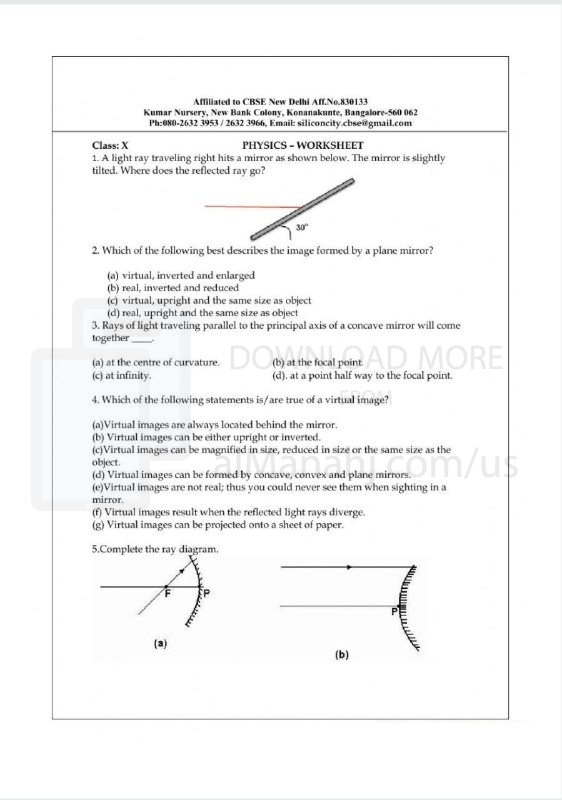| You are here: Almanahj Website ⇒ American curriculum ⇒ 12th Grade ⇒ Physics ⇒ Term 1 | ||
|---|---|---|
Worksheet about Ray diagram | ||
|---|---|---|
| Subject: Physics | ||
| 12th Grade | ||
| Term 1 | ||
| Year: 2023/2024 | ||
| Size: 263.3KB | ||
| Number of clicks: 153 | ||
| Publish date:November 03, 2023 | ||
| Added by: Eman | ||
| Last download date: 2024-09-13 16:15:12 | ||
| Updated by: Eman9966 on 2023-11-03 16:13:35 | By: theodor shravana | |
| File info: Info The "Ray Diagram Worksheet in Physics" is a resource designed to help students understand and practice the construction of ray diagrams in the context of optics. This worksheet focuses on the principles of reflection and refraction of light, allowing students to develop their skills in drawing accurate ray diagrams to analyze the behavior of light rays. 1. Introduction to Ray Diagrams: The worksheet begins with an introduction to the concept of ray diagrams in optics. Students are reminded of the importance of ray diagrams in understanding how light behaves when it interacts with various optical components, such as mirrors and lenses. They review the basic terminology related to light rays, including incident rays, reflected rays, and refracted rays. 2. Reflection: The worksheet covers the construction of ray diagrams for reflection. Students learn how to draw incident rays, normal lines, and reflected rays when light interacts with plane mirrors and curved mirrors (such as concave and convex mirrors). They practice identifying the location and nature of the images formed by different types of mirrors. 3. Refraction: The worksheet focuses on the construction of ray diagrams for refraction. Students learn how to draw incident rays, normal lines, and refracted rays when light passes through different media, such as air, water, and glass. They explore the behavior of light rays when they encounter interfaces between media with different refractive indices. Students practice determining the direction and characteristics of refracted rays and analyzing the formation of images in refracting surfaces. 4. Thin Lenses: The worksheet introduces the construction of ray diagrams for thin lenses. Students learn how to draw incident rays, normal lines, and refracted rays when light passes through converging lenses (convex lenses) and diverging lenses (concave lenses). They practice identifying the location and properties of images formed by different types of lenses. 5. Optical Instruments: The worksheet explores the use of ray diagrams in analyzing the functioning of optical instruments, such as microscopes and telescopes. Students learn how to draw ray diagrams to understand how these instruments magnify and focus light rays to form clear and enlarged images. 6. Practice Exercises: The worksheet includes a series of practice exercises where students are presented with various scenarios and asked to construct corresponding ray diagrams. Students apply their understanding of reflection, refraction, and lens properties to accurately draw incident rays, normal lines, and refracted rays. They analyze the behavior of light rays and determine the nature and position of images formed in each scenario. 7. Critical Thinking and Application: The worksheet includes critical thinking questions and application exercises to foster deeper understanding and analytical skills. Students are presented with real-world situations that require them to apply their knowledge of ray diagrams to explain optical phenomena or solve practical problems related to optics. 8. Reflection and Summary: The worksheet concludes with a reflection section where students summarize their understanding of ray diagrams and their application in optics. They are encouraged to reflect on the significance of ray diagrams in understanding and analyzing the behavior of light and their relevance to various fields, such as photography, astronomy, and ophthalmology. the "Ray Diagram Worksheet in Physics" provides students with a structured approach to understanding and constructing ray diagrams in the context of optics. By engaging with the activities, students develop their skills in accurately drawing incident rays, normal lines, and refracted rays, allowing them to analyze and predict the behavior of light in different optical scenarios. The worksheet promotes a deeper understanding of the principles of reflection and refraction and their practical applications in various optical devices and systems. | ||
| Downloading link Worksheet about Ray diagram |
|---|
|
1699027669.pdf
The file is being prepared for download
|
| File images |
|---|
 |